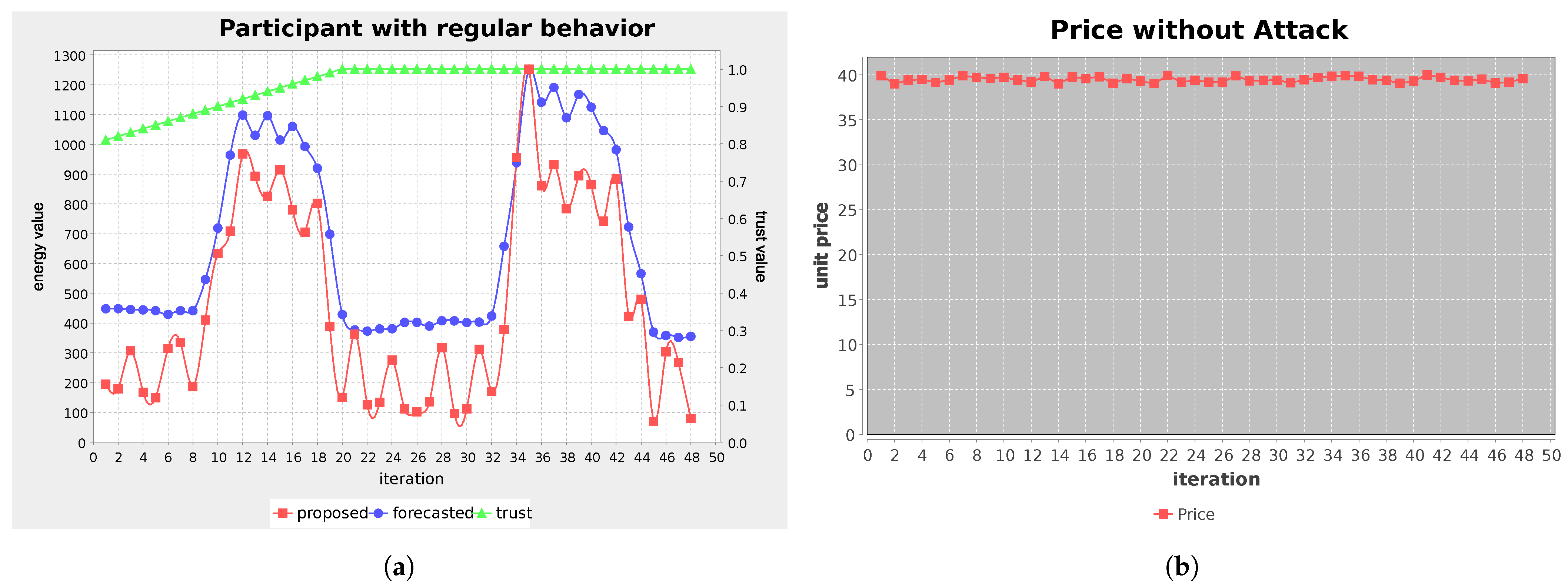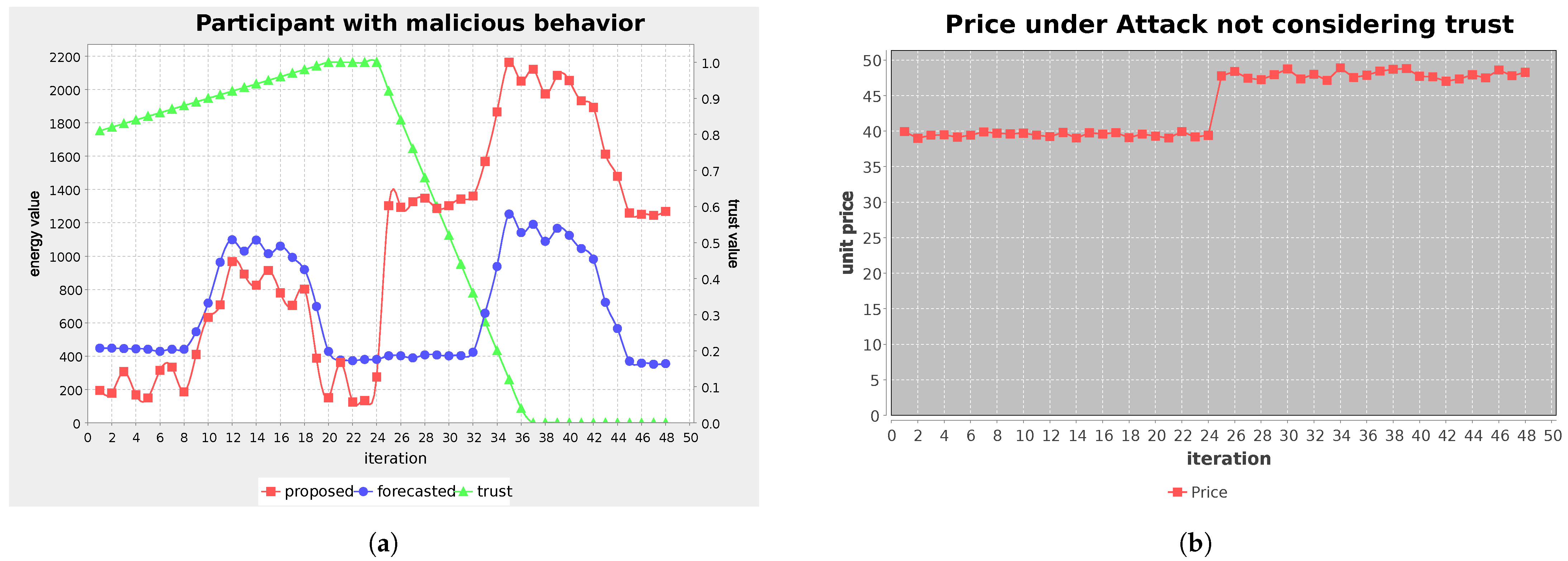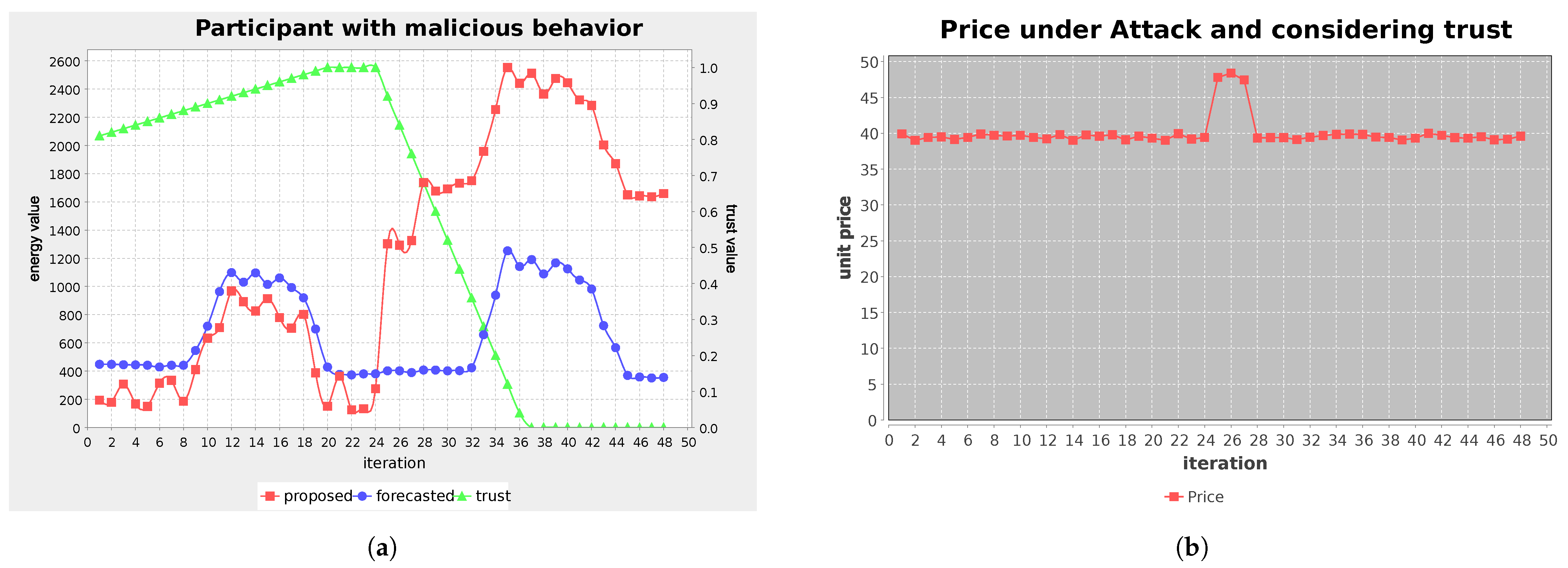The Impact of Attacks in LEM and Prevention Measures Based on Forecasting and Trust Models
Abstract
1. Introduction
2. Context
2.1. Local Energy Market
- Consumers:who wish to purchase electrical energy;
- Producers: who wish to sell electricity;
- Prosumers: (consumers with some source of energy generation) who wish to purchase and sell electrical energy.
2.2. Security and Cyber-Attacks in Local Energy Markets
- High Level Security—cyber-security attacks such as Man-in-the-Middle (MitM), Denial of Service (DoS), and others must be defended against;
- Privacy—sensitive information must be kept secure;
- Availability—critical systems and services must avoid down time;
- Integrity—data must not be corrupted or inappropriately modified;
- Authentication—only legitimate participants should have access to the system;
- Authorization—participants should only have access to parts of the system that concern them;
- Auditability—it must be possible to analyze the historical data of the system;
- Non-repudiability—there must be no ambiguity in the origin of data;
- Third-party Protection—the systems must be protected against third-parties;
- Trust—all parts of system must be trustworthy in order for the system as a whole to be trustworthy.
- Participants must be authenticated;
- Participants must be authorized;
- Participation needs to be non-repudiable;
- Integrity of data is needed.
2.3. Forecasting
3. Technologies and Implementation
3.1. LEMMAS
- MIM—Market Interactions Manager (MIM) is the agent responsible for performing the negotiation as well as interacting with the Trust and Forecasting tools;
- Participant—this agent represents a real market participant. This agent is capable of sending proposals to the MIM in order to negotiate energy according to his needs;
- Sensor—the sensor agent is an intermediary between the real world information collected by sensors or external sources, and the respective participant agent, which in tern uses this information to evaluate his energy needs.
3.2. Forecasting Tool
- Adaboost.R2;
- Random Forest;
- Gradient Boosting Regressor;
- Support Vector Regressor;
- Linear Regressor.
- Training Module: to build forecasting models to be used later for forecasting energy consumption;
- Tuning Module: to tune forecasting models using combinations of input parameters and historical data values;
- Predicting Module: to predict next values using the model resulting from the training module.
3.3. Trust Tool
4. Experimental Findings
4.1. Case Study
- the first scenario represents a market performing trading without malicious activities;
- in the second scenario, one of the markets participants starts sending adulterated proposals after the first 24h in order to influence the market outcome;
- last scenario is the same as the previous one, however this time the Trust model is used in order to identify and prevent the malicious activities.
- “day_m”—day of the month in this period;
- “month”—month in this period;
- “hour”—hour in this period;
- “year”—year in this period;
- “day_w’—day of the week in this period;
- “temp”—temperature in participant’s location this period;
- “prev_1”—participant’s consumption or generation in the previous period;
- “prev_2”—participant’s consumption or generation two periods ago;
- “prev_3”—participant’s consumption or generation three periods ago;
- “value”—participant’s amount of energy proposed to buy or sell;
- “buy”—participant’s price bid to buy energy;
- “sell”—participant’s price bid to sell energy.
4.2. Results
5. Conclusions
Author Contributions
Funding
Institutional Review Board Statement
Informed Consent Statement
Data Availability Statement
Conflicts of Interest
References
- Abidin, A.; Aly, A.; Cleemput, S.; Mustafa, M.A. Towards a Local Electricity Trading Market Based on Secure Multiparty Computation. 2016. Available online: https://www.esat.kuleuven.be/cosic/publications/article-2664.pdf (accessed on 7 February 2021).
- Andrade, R.; Pinto, T.; Praça, I. Trust Model for a Multi-agent Based Simulation of Local Energy Markets. In Proceedings of the International Conference on Practical Applications of Agents and Multi-Agent Systems, Seville, Spain, 1–3 June 2020; pp. 183–194. [Google Scholar]
- Praça, I.; Ramos, S.; Andrade, R.; da Silva, A.S.; Sica, E.T. Analysis and Simulation of Local Energy Markets. In Proceedings of the 2019 16th International Conference on the European Energy Market (EEM), Ljubljana, Slovenia, 18–20 September 2019; pp. 1–5. [Google Scholar]
- Bremdal, B.A.; Olivella, P.; Rajasekharan, J. EMPOWER: A network market approach for local energy trade. In Proceedings of the 2017 IEEE Manchester PowerTech, Manchester, UK, 18–22 June 2017; pp. 1–6. [Google Scholar] [CrossRef]
- Ampatzis, M.; Nguyen, P.H.; Kling, W. Local electricity market design for the coordination of distributed energy resources at district level. In Proceedings of the Innovative Smart Grid Technologies Conference Europe (ISGT-Europe), 2014 IEEE PES, Istanbul, Turkey, 12–15 October 2014; pp. 1–6. [Google Scholar]
- Teotia, F.; Bhakar, R. Local energy markets: Concept, design and operation. In Proceedings of the Power Systems Conference (NPSC), 2016 National, Odisha, India, 19–21 December 2016; pp. 1–6. [Google Scholar]
- Mendes, G.; Nylund, J.; Annala, S.; Honkapuro, S.; Kilkki, O.; Segerstam, J. Local energy markets: Opportunities, benefits, and barriers. In Proceedings of the CIRED 2018 Ljubljana Workshop on Microgrids and Local Energy Communities, Ljubljana, Slovenia, 7–8 June 2018. [Google Scholar]
- Etukudor, C.; Couraud, B.; Robu, V.; Früh, W.G.; Flynn, D.; Okereke, C. Automated negotiation for peer-to-peer electricity trading in local energy markets. Energies 2020, 13, 920. [Google Scholar] [CrossRef]
- Yan, Y.; Qian, Y.; Sharif, H.; Tipper, D. A Survey on Cyber Security for Smart Grid Communications. IEEE Commun. Surv. Tutor. 2012, 14, 998–1010. [Google Scholar] [CrossRef]
- Ericsson, G.N. Cyber Security and Power System Communication—Essential Parts of a Smart Grid Infrastructure. IEEE Trans. Power Deliv. 2010, 25, 1501–1507. [Google Scholar] [CrossRef]
- Wang, W.; Lu, Z. Cyber security in the Smart Grid: Survey and challenges. Comput. Netw. 2013, 57, 1344–1371. [Google Scholar] [CrossRef]
- Gunduz, M.Z.; Das, R. Cyber-security on smart grid: Threats and potential solutions. Comput. Netw. 2020, 169, 107094. [Google Scholar] [CrossRef]
- Raza, M.Q.; Khosravi, A. A review on artificial intelligence based load demand forecasting techniques for smart grid and buildings. Renew. Sustain. Energy Rev. 2015, 50, 1352–1372. [Google Scholar] [CrossRef]
- Antonopoulos, I.; Robu, V.; Couraud, B.; Kirli, D.; Norbu, S.; Kiprakis, A.; Flynn, D.; Elizondo-Gonzalez, S.; Wattam, S. Artificial intelligence and machine learning approaches to energy demand-side response: A systematic review. Renew. Sustain. Energy Rev. 2020, 130, 109899. [Google Scholar] [CrossRef]
- Jain, A.K.; Mao, J.; Mohiuddin, K.M. Artificial neural networks: A tutorial. Computer 1996, 29, 31–44. [Google Scholar] [CrossRef]
- Murat, Y.S.; Ceylan, H. Use of artificial neural networks for transport energy demand modeling. Energy Policy 2006, 34, 3165–3172. [Google Scholar] [CrossRef]
- Ahmad, A.S.; Hassan, M.Y.; Abdullah, M.P.; Rahman, H.A.; Hussin, F.; Abdullah, H.; Saidur, R. A review on applications of ANN and SVM for building electrical energy consumption forecasting. Renew. Sustain. Energy Rev. 2014, 33, 102–109. [Google Scholar] [CrossRef]
- Ahmad, M.W.; Mourshed, M.; Rezgui, Y. Trees vs Neurons: Comparison between random forest and ANN for high-resolution prediction of building energy consumption. Energy Build. 2017, 147, 77–89. [Google Scholar] [CrossRef]
- El-Baz, W.; Tzscheutschler, P.; Wagner, U. Integration of energy markets in microgrids: A double-sided auction with device-oriented bidding strategies. Appl. Energy 2019, 241, 625–639. [Google Scholar] [CrossRef]
- Pedregosa, F.; Varoquaux, G.; Gramfort, A.; Michel, V.; Thirion, B.; Grisel, O.; Blondel, M.; Prettenhofer, P.; Weiss, R.; Dubourg, V.; et al. Scikit-learn: Machine learning in Python. J. Mach. Learn. Res. 2011, 12, 2825–2830. [Google Scholar]




| Name | Days for Forecasting | Min Bid €/MWh | Max Bid €/MWh |
|---|---|---|---|
| domestic consumer 1 | 9 | 34 | 46 |
| domestic consumer 2 | 4 | 34 | 46 |
| domestic consumer 3 | 9 | 36 | 48 |
| domestic consumer 4 | 18 | 36 | 48 |
| domestic consumer 5 | 8 | 38 | 48 |
| domestic consumer 6 | 440 | 38 | 48 |
| domestic consumer 7 | 1 | 38 | 50 |
| domestic consumer 8 | 8 | 38 | 50 |
| domestic consumer 9 | 8 | 40 | 50 |
| domestic consumer 10 | 23 | 40 | 50 |
| domestic consumer 11 | 2477 | 34 | 46 |
| domestic consumer 12 | 62 | 36 | 48 |
| industrial consumer 1 | 1393 | 36 | 50 |
| industrial consumer 2 | 1393 | 34 | 48 |
| industrial consumer 3 | 1393 | 34 | 48 |
| generation 1 | 342 | 40 | 52 |
| generation 2 | 3 | 42 | 52 |
| generation 3 | 3 | 40 | 52 |
| day_m | month | hour | year | day_w | temp | prev_1 | prev_2 | prev_3 | value | buy | sell |
|---|---|---|---|---|---|---|---|---|---|---|---|
| 01 | 03 | 02 | 2018 | 4 | 5 | 458.21 | 473.68 | 453.51 | 450.60 | 41.14 | 0 |
| 01 | 03 | 03 | 2018 | 4 | 5 | 450.60 | 458.21 | 473.68 | 446.67 | 42.17 | 0 |
| 01 | 03 | 04 | 2018 | 4 | 5 | 446.67 | 450.60 | 458.21 | 428.78 | 42.64 | 0 |
| 01 | 03 | 05 | 2018 | 4 | 5 | 428.78 | 446.67 | 450.60 | 443.11 | 40.66 | 0 |
Publisher’s Note: MDPI stays neutral with regard to jurisdictional claims in published maps and institutional affiliations. |
© 2021 by the authors. Licensee MDPI, Basel, Switzerland. This article is an open access article distributed under the terms and conditions of the Creative Commons Attribution (CC BY) license (http://creativecommons.org/licenses/by/4.0/).
Share and Cite
Andrade, R.; Praça, I.; Wannous, S.; Ramos, S. The Impact of Attacks in LEM and Prevention Measures Based on Forecasting and Trust Models. Processes 2021, 9, 314. https://doi.org/10.3390/pr9020314
Andrade R, Praça I, Wannous S, Ramos S. The Impact of Attacks in LEM and Prevention Measures Based on Forecasting and Trust Models. Processes. 2021; 9(2):314. https://doi.org/10.3390/pr9020314
Chicago/Turabian StyleAndrade, Rui, Isabel Praça, Sinan Wannous, and Sergio Ramos. 2021. "The Impact of Attacks in LEM and Prevention Measures Based on Forecasting and Trust Models" Processes 9, no. 2: 314. https://doi.org/10.3390/pr9020314
APA StyleAndrade, R., Praça, I., Wannous, S., & Ramos, S. (2021). The Impact of Attacks in LEM and Prevention Measures Based on Forecasting and Trust Models. Processes, 9(2), 314. https://doi.org/10.3390/pr9020314








